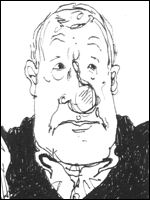Darlene Chan talks with five instructors at leading animation schools about what they are doing to help the animators of tomorrow navigate the harsh realities of the narrowing job market.

Everyday reports on the U.S. job market sound a dire cry: unemployment is up and the number of people searching for jobs is at a record high. Animation has been as hard hit as any other sector of business, and to compound matters, it wasn't so long ago that studios were punch drunk on the bags of money animation could bring in. The Lion King intoxicated the corporate fat cats in the mid-'90s and the powers-that-be spent with wild abandon. Animators were even the subject of bidding wars! Well, Dorothy, it's not the '90s anymore and the animation employment marketplace has taken a drastic downward turn.
Animation World Magazine investigates how the animators navigate and survive the harsh realities of the narrowing job market. Students expect higher education to free their minds and souls and enable them to perfect their drawing technique and storytelling abilities. But how do they learn the skills for securing a job and a career upon graduation? On a very practical level, students have trade tech expectations of their schools. They need to learn how to find the job opportunity that will let them apply all the knowledge they've accumulated. We turned to five respected animation department heads, some of whom are also artists in their own right. We asked them quite bluntly, "What are you doing to prepare your students for job placement?" There's no doubt that every prospective animation student and those presently attending animation programs will be interested in their responses.

Frank Terry Director of the Character Animation Program, CalArts
Frank is currently the Director of the Character Animation Program at CalArts. He received his BFA from the Chouinard Art Institute and focused on advertising commercial production, animated documentaries, titles and entertainment specials. Frank has been based on the west coast since the mid 1960s.
The Character Animation Program here at CalArts, has, by its design and past history, been very connected with the animation industry. While we certainly are not a trade school, we are an art program that expands four years of traditional art study into the understanding of the process of animated narrative theater, or acting animation. To this extent, the fundamental focus of our curriculum has not had to change.
The '90s, however, have brought many side channels to the industry, which we have responded to. We have honed the curriculum in many directions, entrepreneurial understanding being included! Our curriculum is set up to not only instruct "acting animation" but seriously reinforce the student's understanding of "visual problem solving" for all acting requirements for all job markets. Games have one set of needs that are different from those of graphic novels, or of feature films, TV series production is different from advertising or theme park design. And yet our curriculum can and does support the needs of the student to be ready for opportunities in all these areas. Additionally, we are also aware that students need to be ready to "carve out their own territory," and to that extent, even entrepreneurial studies are no longer outside the parameters of acting animation.
As to the job market and job placement, we have simply expanded many of our programs. To help our students understand what opportunities are available, our Visiting Artist Program invites voices from all arenas to talk with the students. These Friday night visits are then augmented with classroom visits by artists coordinated by the instructor of the inviting class. We have a Corporate Presentation Program, which provides a podium for the companies wishing to present their needs to the students. We have a Portfolios in Review day, where the work of the student is placed on display for the industry to review, giving them the ability to track a student's growth through the passing years. This is promoted by widely advertised and flyer-promoted screenings of the students' work.
Job opportunities received by the Department are e-mailed to all the students on our internal e-mail trees so that they may respond directly to the inquiring source, We are adding the portfolios of the graduating class to the CalArts Character Animation Website, for the ease of the industry in finding talented acting animators. Finally, the Department is very busy keeping in touch with international production areas so that we can also refer quality artistic talent whenever need is expressed. In short, it is quite a full job keeping in touch with where and what the animation industry is up to, but one we enjoy taking on.

Jim McCampbell Department Head, Computer Animation, Ringling School of Art & Design
Jim McCampbell began his career as a graphic designer. He started doing computer animation in 1986, working for several film and video production companies with national clients. He has been teaching at Ringling School of Art & Design in Sarasota, Florida since 1995, where he is department head of the Computer Animation major.
Ringling School of Art and Design's Computer Animation major is quite distinctive in several different ways. First, unlike most other institutions, ours is truly a four-year BFA program in Computer Animation. Although many other schools may claim that they have a Computer Animation major, the reality is that most only have a few individual courses on the subject. This is simply not enough for someone who aspires to be a professional animator in todays competitive world.
Next, the structure of our curriculum is unique. We have worked very hard to create a balance between the conceptual and the technical. In parallel with learning the latest technology, students learn all of the important aspects of concept development and story development. Ours is a philosophy of communication through movement, so it is very important to have a great idea to communicate. Our student work is highly successful and universally well-received because it is not only technically sound, but also because of the unique designs and interesting stories as well. Our students think.
Our department prides itself on the fact that its curriculum is deep, not wide. Many other schools adopt an approach of having students sample a broad spectrum of tools and techniques that are used in a wide range of computer graphics applications. Instead, Ringling School students delve deeply into 3D animation as an art form. With our concentrated focus, we are able to address the subtle nuances that distinguish movement from true animation. Although we are character animation heavy, we do teach our students to have a complete range of skills in the area of 3D. This opens up a broader range of opportunities for them because we are discovering that there is a current trend toward increasing the responsibilities of the artist in studios today. Having artists with a complete skill set allows studios to have a smaller, more efficient company which keeps more full time employees since the artists are able to be productive in every phase of a project instead of in just one area.
Lastly, at Ringling School of Art and Design, we are focused on instilling the desire in our students to become lifelong learners. This means not only learning the conceptual and technical skills necessary to succeed in today's professional world, but also to embrace the notion of change and the opportunity to continue to learn and grow throughout one's career. The result is a graduate that understands the importance of anticipating future trends and aligning themselves appropriately.

John Canemaker Director of the Animation Program, NYU
John Canemaker is a tenured full professor at NYU Tisch School of the Arts, and, since 1988, Director of the Animation program there. His personal animated films are part of the permanent collection of the Museum of Modern Art and are distributed on DVD by Milestone/Image Entertainment. He is the author of nine books on animation history, including his latest, The Art and Flair of Mary Blair (Disney Editions, fall 2003).
In today's economic environment, students in all disciplines must broaden their horizons. The enormous expansion of the animation industry in the last decade includes not only TV series and theatrical features, but the Internet, games and special effects for live-action features. Digital technology has merged live-action and animation a fundamental shift in aesthetics pointing toward a new art form and a re-defining of animation itself. New York University Tisch School of the Arts offers a balance of introductory and advanced 2D and 3D computer techniques alongside traditional drawing and visual communication skills (such as Life Drawing, Storyboarding, Action Analysis, Stop Motion, among others). Animation-focused students are also encouraged to partake of the Film Department's multiple offerings in Scriptwriting, Cinematography, Editing, Sound Design, Acting and Cinema History classes. A university is a place of exploration where students develop not only technical skills but a sense of themselves as creative individuals. To land that all-important entry level position, a "calling card" film project should be an expression of who they are and what they have to offer as artists as well as a showcase of their varied moving image-making skills.

Miroslaw Rogala Ph.D., Professor and Department Chair, Computer Graphics and Interactive Media, Pratt Institute, New York
Miroslaw Rogala is an internationally recognized interactive media artist. His work is represented in exhibitions in 42 countries and permanent collections, including the Lyon Biennale, ZKM Multimediale and Center for Art and Media, The Brooklyn Museum and the Chicago Museum of Contemporary Art. He researchrs and lectures globally in the area of Interactive Public Art and artist/(v)user (viewer-use) participant relationships.
With the explosion of new techniques and applications in the last several years, the Computer Graphics and Interactive Media Department at Pratt Institute has greatly expanded our course offerings to reflect and address these innovative methods and skills. Our curriculum improvement has coincided with the economic downturn we have made an overhaul at the moment when the market became more competitive. As an adjunct to introductory courses, we impart a variety of advanced, special topics courses. For example we offer character design and modeling, character animation, motion dynamics, 3D for the Web, 3D game graphics, non-narrative animation, animation production-team, advanced lighting and texturing.
As the market changes, we rotate through these courses, and keep adding new courses. In addition, we offer non-computer graphics animation courses through our universitys Media Arts Dept, including cel animation, stop-motion animation, character animation, etc. We have become much more specialized at precisely the moment when this is needed most. Our faculty reviews portfolios and provides students with feedback, including simulated "interviews" with students to prepare for interviewing situations. Within the classroom, emphasis is placed on the importance of professional presentations/practices, making students aware of the competitive nature of the field and providing each with the means to compete. Depending on the direction in which students want to go, we distinguish between commercially viable work and approaches that could be considered more "fine art."
Of primary importance for professional work experience and future employment is an on-going internship course with New York City companies. Networking with alumni and professional resources through our departments diverse faculty connections/involvements is a major avenue for employment and recruitment. Students are encouraged to attend conferences such as SIGGRAPH. Undergraduate students are urged to consider graduate school. The faculty also stresses that students should complete senior projects well ahead of schedule in order to be competitive in the market.

Joan Ashworth Head of Animation, The Royal College of Art
After graduating from the National Film and Television School in 1987, Ashworth co-founded 3 Peach Animation through which she directed many commercials, title sequences and stings for TV and cinema including the opening titles for Tim Burtons Batman. She joined the RCA in 1994, becoming professor of animation in 1998. Since joining the RCA Ashworth has continued working as animator. Recently, Ashworth completed a 10-minute film How Mermaids Breed inspired by Bronze Age Cycladic fertility figures, the drawings of Henry Moore and Birling Gap Beach, Sussex.
The two-year MA Course at the Royal College of Art focuses on students finding their own voice and developing the skills to communicate their ideas. We encourage students to develop creative problem-solving abilities that give them transferable skills. If they choose not to stay in animation, they can then apply their skills to other areas.
Learning to research intuitively and questioning the design problem is important and yields creative results. Learning to present work in an engaging way shows an understanding of the audience. Because students will need to stand out in the jostling for independent film funding, we encourage students to develop their writing and business skills. These are taught through creative writing workshops, professional practice workshops and the embedded and personal examples of most filmmakers who present their work at the college.
During the course, the students' strengths and saleable skills become obvious and they are made aware that they could consider applying these skills in a commercial environment, and some students choose to embrace this route. Others combine selling these skills with creating their own projects. It is not always easy to keep a balance, but the staff at the college show the example of balancing teaching with independent production and commercial work.
Flexibility of the mind, creative risk-taking and the practical ability to understand what is needed to realize a project through all its twists and turns are key elements examined on the course. These are all elements required in the workplace and most students graduate with these skills in place and a hunger to create more.
An alumna of UCLA, Darlene Chan has worked in the motion picture industry for 14 years. She served as a production executive for Paramount Pictures, Walt Disney Pictures, Davis Entertainment and Motown. She produced Grumpy Old Men (1993) for Warner Bros. In 2001, she joined Animation World Magazine as general manager and was named managing editor in 2002.







